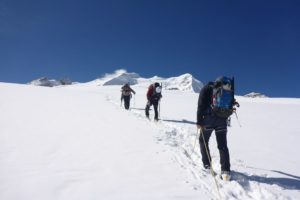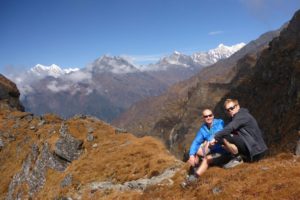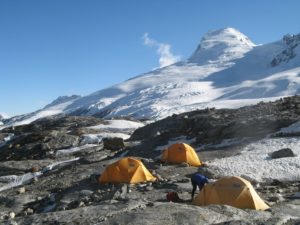The stuff they don’t tell you in the text-book.
What’s next? You’ve caught the bug. You loved Kilimanjaro and have developed a taste for experiencing different cultures, amazing mountain scenery and pushing yourself to the limit. You want more but what could possibly trump Kilimanjaro? The answer is easy: Mera Peak.
The journey to this mountain and the ascent to its icy summit is like no other. Forget the crowds, think real Nepal, incredible vistas and the chance to taste 6,000 meters above the deep blue sea. By far the most often asked question about climbing in Nepal is “Why haven’t I come here before!?”
What makes it so special is that this journey has all the elements of a great Himalayan expedition; a long approach trek through the heart of an ancient culture, untouched wilderness, a realistic chance to get acclimatised by gently gaining altitude, a dramatic 3 day climb up a spectacular glacier and a view from the top that is beyond belief. I say journey because even though standing on the summit is always nice you will soon see that the experience of just being here is what becomes all-encompassing. Day to day life on your journey to the top changes dramatically and cannot fail to totally enchant you. So you want to know what’s next after having taken the plunge into this amazing world of mountain trekking; there really is only one answer.


Are you ready for the long way round? “Team members wanted, NO experience required but must be willing to have life changing experience” This add sums up an expedition to Mera Peak perfectly. “What?” I hear you shout, “No experience required??” the guy has got to be nuts! Please consider this – I have summited Mera Peak with a vast array of folk over the years including a grand-mother of 2, a rather large guy who smoked plenty of cigarettes and a hedge fund manager who’d never left London. These successful people had 2 things in common, none had done a day’s trekking in their lives and each had an open adventurous mind. For a long expedition like this, this is what will get you to the top as much as having spent 2 years in a gym pumpin’ iron.
The proper approach to Mera Peak is gentle walking, and a good guide who will instruct you on how to deal with the obstacles you may encounter when and if they appear. The best itineraries are designed to get you to the top by making sure that by the time you get to the high camp you are trekking fit, acclimatised and into the rhythm of the expedition. The long way round is also spectacularly beautiful and provides a fascinating insight into the real Nepal and Sherpa life. So what is the long way round? Physically it’s a variation of the route into the Hinku valley and to Mera basecamp that takes a few days longer than the quick way around and most importantly breaks the climb from the basecamp to the summit into 3 distinct phases:
- Basecamp (5,000 meters) to the Mera La (5,350 meters, 6-7 hrs)
- Mera La to high camp (5,800 meters; 4 -5 hrs) and
- The summit bid

The benefits are obvious and gives you the best chance of standing on the summit. Mentally, it’s better to have these extra days to gel with your team buddies, to get properly into the trek, adjust to the local food, the local bugs, and the trekking pace for the team. And of course, the big one is getting properly acclimatised.

A little knowledge does go a long way Of course having just mentioned the thing about no experience being necessary I need to add that having a basic background does go a long way. If you are used to wandering about the British hills and moors carrying a 5 kg rucksack containing lunch and a camera than the approach to the basecamp of Mera Peak will be a pleasure and not a herculean feat. The fitter you are the less you’ll struggle. Ask any 70 year old Sherpani carrying her exact age in kilos of wood as she storms past you going uphill, she’ll tell you that replicating what you will be doing on the mountain is exactly what you need to be doing at home. This makes sense, if you can carry a 5kg rucksack without much difficulty on the hills at home than why wouldn’t this be the case in Nepal? Again here it is important to remember your approach to climbing Mera Peak. You are trekking at a higher altitude than in the UK but sensibly you have signed up for the long way around which starts in Lukla at 2,800 meters and only just brings you over 4,000 meters on your fourth day of trekking. The altitude is not going to be a significant problem if given plenty of time to acclimatise properly.
Apart from having become walking fit prior to flying out to Nepal, it also helps enormously to have done a little camping before. Having been on an expedition to somewhere like Kilimanjaro will pay dividends. And here I don’t mean being a proficient camp cook or pitching a tent in under 3 minutes, this is done for you by your Sherpa crew. But how to deal with the stuff they don’t mention in the text-books – how to cope with being away from home for an extended amount of time, how to best stave off boredom whilst sitting out a storm and how to move at a pace that gets you not only through the day but allows you to have enough battery power in reserve for the next day and the day after that. Once again a good guide will help you through these aspects of expedition life as well as dealing with practicalities like putting on your crampons the right way around!

The next thing to consider is your experience level, the level of comfort you want, your budget and the amount of time you can get off work. Put simply: should you go at this alone and enjoy the obvious satisfaction that comes with this or should you sign up for an organised trek that takes the sting out of many logistical hassles. As a basic rule of thumb consider that organising your own trip will be around 30% cheaper but also entails 30% more time in sorting out flights, trek logistics, prior research and tea-house booking etc. A plus for a reputable trekking company which works closely with the local people will be that they include a lot more in an itinerary than solo trekkers would have time for when continuously having to fret about additional spending and those carefully planned logistics not working out. An organised trekking group can submerge themselves into the experience much more as the logistical hassles are dealt with by professionals.


The right stuff Having said this how do you go about picking the right company? The answer to this is to not just slide your finger down the list and say “this’ll do” but to ask lots of questions and compare what is on offer. How long have they been operating in Nepal? Have the trek leaders in their employ been to Mera Peak before and do they have a good relationship with the locals. Is your western guide a mountain professional who will do his utmost to help you summit? What, despite the advertised price of their itinerary is included and not included? Are there going to be any unpleasant financial surprises once on the way to the mountain? And for Mera Peak in particular, how much time do you spend trekking to basecamp? And by what route do they approach the mountain? Is there going to be enough time to acclimatise? What medical and emergency equipment do the trek leaders carry? Are they trained to use it? Why is there such a price difference between companies? Are they doing all they can to get you to the top? Knowing the answers to questions like these will go a long way to picking a reputable company that can deliver on their promise of providing you a climb of a lifetime.

Does my bum look big in this? What to wear? What to take? This question is hard enough to answer when heading out on the town let alone flying halfway around the world to climb the in the Himalaya. In one case you’ll be aiming to flatter and the other you’ll be wearing what’s right for conditions. So what are those conditions? Kathmandu is hot and steamy, think summertime UK, so wear what you wear in summertime UK. The trek into Mera Peak basecamp can be cold and frosty so wear what you wear when it’s cold and frosty. It’s that simple. Of course, if trekking with a trekking outfitter you will not have to worry about carrying the clothes and equipment to deal with these widely ranging conditions but the porters they employ will do this job for you. The average weight allowance for the porter load is in the order of 20 kg per person.
So what do you take along for this trek? Personally I start wearing summer gear, light trekking trousers, a light long sleeve shirt and a hat. Inside my daysack (30 litres) I always carry a fleece and full set of waterproofs (top and bottom) I am in the mountains after all and even though the sun is shining they can unleash their fury at any time. Additionally I pack sun protection, a small first aid kit, a camera and a water bottle. For demanding days, I might pack a snack or two. My daysack never weighs more than 4 kg.
In my porter bag I have the clothing and equipment that I will need for the climb itself and for when conditions turn cold and frosty on the trek in, plus I have a very cool minus something ridiculous Berghaus sleeping bag to withstand the extremely cold temperatures on the Mera La and high camp; I use it as a duvet on the trek in and zip the thing up tight on the mountain. As I gain altitude I add a pair of gloves and a beanie to my daysack and perhaps a thin down jacket in case that snow-storm does come through.
For the climbing above basecamp to high-camp I wear a thermal base layer layered with a fleece or wind-stopper. Inside my daysack I now carry a heavy duty down jacket plus a water/windproof Gortex shell. In combination these layers will allow me to stay warm even when Mother Nature throws her worst at me. For my legs I usually begin to put on a thermal layer when I get above 4,000 meters.
When packing my trekking clothes before I leave for the higher camps I always adhere to the principal of having one “wet” set for the hill and one “dry” set for the camp. With this I mean I pack a dry comfortable warm set of clothes and socks in my porter bag that I only wear at the camps.

For the summit climb you will be leaving in the dark and it can be bitterly cold. I usually leave for the top fully dressed for the conditions ahead: in addition to my thermal top and bottom layers I will be wearing top and bottom fleece layers and a down gilet on my torso and sometimes down trousers. On my torso I also wear a heavy duty down jacket with hood. Additionally I wear full length salopettes over my legs and sport a thick beanie under the hoods of my jackets. On my hands I like to wear a thin silk gloves then a thick fleecy pair of gloves over the top of which I wear expedition down mitts. For climbing anything over 6,000 meters I never leave the tent without wearing double plastic climbing boots. The recommended work-horses for your feet should be the La Sportiva Spantik or the Scarpa Vega at the very least. They never say this in the sexy ads but Mera Peak eats fingers and toes. Be sure you have the right stuff! Reputable experienced climbing outfitters have kit-lists to get you to the top and come back with all bits wriggling. Do not be afraid of asking them further about the finer details of the recommended kit list they supply for your climb. And of course nowadays even the question of your bum looking big in this has become irrelevant; simply click that Berghaus link for the kit that is not only functional but pretty dammed stylish to boot!

Ouch I have a blister! The most important item to consider before embarking on a trek like this is your boots. The terrain to basecamp is extremely varied and is mostly uneven, rocky and can be iced up or snowy. It’s imperative that you have the right boots that can cope with this variety of conditions. Boots need to be warm, offer proper ankle support and be tough enough to deal with walking for 2 weeks in arduous terrain. And your feet need to be equally tough. Break those boots in on the recommended training walks and by the time you get to wear them on the big trek itself they’ll feel like silk gloves and you’ll want to wear them to bed! You don’t want to be the guy who nearly made it but was crippled by blisters.

Climbing above the basecamp and particularly on the summit night can be extremely cold. Proportionally more climbers get frost injuries on Mera than any other mountain in the world. Yep you read that correctly. Be sure that you source (beg, steal borrow) the above mentioned boots. The number of times I have heard climbers rave about the virtues of boots like La Sportiva Nepal Evo’s only to come back with a toe or two missing are numerous. Remember Mera Peak is well over 6,000 meters and is a very different beast than Scotland or the Alps.


The simple things in life. There are plenty of other things to think about when travelling in a developing country, the most important being hygiene. When it comes to personal hygiene it pays to be vigilant and to pay attention to detail. Was my shoe-lace undone before I stepped into the long-drop? Getting Delhi-Belly can totally ruin your experience so use that hand gel and wash your hands before every meal. Also be aware that hydration helps in acclimatisation. Drink at least 2 to 3 litres of water per day (additional liquid will be provided in forms of soup, hot-drinks etc.) and understand that for every 1,000 meters you ascend your sun creams ability to protect you decreases by 5 factors. Most of the trek is over 4,000 meters so factor 20 sun protection doesn’t work. Your trek leader will help you get into the swing of things and point out the details that can make a huge difference to the outcome of the trek. Never be shy to ask a question. The most stupid question is the one that’s never asked.
Mind over matter; summit day and pre-summit nerves On summit day every doubt and fear so carefully hidden comes alive. A good guide teamed up with powerhouse Sherpas will have heard it all and it is their job to make your dream come true, if there are no physical or medical limitations, then you are going to the top. The mental bit is up to you. I can well remember times as a rookie Alpinist lying wide awake in near panic before that mountain wall we were going to climb the next morning. How I fretted and imagined the worse-case scenario over and over again. So what to do before this great moment? It pays to put things into perspective from a practical point as well as a mental point of view, you have paid a lot of money for this, you have invested a lot of clothes and equipment and begged your boss for more holiday time, you have trained hard and you felt great on the equally big days on the trek to the high camp. So what to do? Well, I always say to my folk, “Chill the f*$% out!”. This of course is easier said than done, the pressures are enormous, there’s so much prior publicity, self-condemnation, sponsor obligation or external expectation. But now it becomes a moment about YOU and no-one else. This is a moment to think about all the mental positives that have gone right on you reaching this lofty spot. You have been eating amazing food, there have been no medical issues, you are feeling ok, you are getting on famously with your Guide and Sherpas and team, you have truly enjoyed the whole Nepal experience and you have confidence in your equipment and clothing. If nothing else this has been a trip of a lifetime, what is coming up will be the icing on the cake and really fulfil every wish. And most importantly you know you are in great hands and it will only take 6 hours to reach the summit. You have trekked for 12 days to be here; so what is six more hours? Just hang in there and you’ll be rewarded with the summit of this incredible mountain.